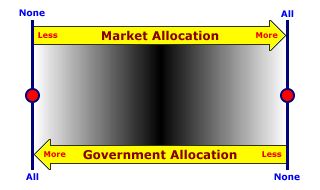
|
|
TOTAL PRODUCT AND MARGINAL PRODUCT: A mathematical connection between marginal product and total product stating that marginal product IS the slope of the total product curve. If the total product curve has a positive slope (that is, is upward sloping), then marginal product is positive. If the total product curve has a negative slope (downward sloping), then marginal product is negative. If the total product curve has a zero slope (horizontal), then marginal product is zero. Moreover, if the total product curve has a positive and increasingly steeper slope, then the marginal product is positive and rising. If the total product curve has a positive and decreasingly steeper slope, then the marginal product is positive but falling.
Visit the GLOSS*arama
|
|


|

|
                           PURE MARKET ECONOMY: An economy, or economic system, that relies exclusively on markets to allocate resources and to answer all three questions of allocation. This theoretical ideal has no governments, markets are used to make all allocation decisions. Then contrasting theoretical ideal is a pure command economy in which governments make all allocation decisions. | Economic Systems |  |
A pure market economy is a theoretical extreme on the spectrum of economic systems that does not actually exist in the real world. It does, however, provide a benchmark that can be used for comparison with real world economic systems. In pure market economies, markets are used by buyers and sellers to voluntarily exchange goods, services, and resources. Buyers seek to pay the lowest prices. Sellers seek to receive the highest prices. Resources are allocated to the production of the goods with the highest prices and greatest satisfaction of wants and needs. The real world embodiment of a pure market economy is termed a market-oriented economy or capitalism. The market-oriented economy of the United States is the primary example. While, in theory, resource allocation could be undertaken exclusively through markets or governments, in the real world, all economies rely on a mix of both markets and governments for allocation decisions, what is termed a mixed economy.

Recommended Citation:PURE MARKET ECONOMY, AmosWEB Encyclonomic WEB*pedia, http://www.AmosWEB.com, AmosWEB LLC, 2000-2025. [Accessed: July 3, 2025].
Check Out These Related Terms... | | | | | | | |
Or For A Little Background... | | | | | | |
And For Further Study... | | | | | | |
Search Again?
Back to the WEB*pedia
|



|

|
GRAY SKITTERY
[What's This?]
Today, you are likely to spend a great deal of time at a going out of business sale looking to buy either a wall poster commemorating the 2000 Presidential election or a rechargeable flashlight. Be on the lookout for fairy dust that tastes like salt.
Your Complete Scope
This isn't me! What am I?
|

|
|
It's estimated that the U.S. economy has about $20 million of counterfeit currency in circulation, less than 0.001 perecent of the total legal currency.
|

|
|
"Far and away the best prize that life has to offer is the chance to work hard at work worth doing." -- Theodore Roosevelt, 26th US president
|

|
JPE
Journal of Political Economy
|

|
|
Tell us what you think about AmosWEB. Like what you see? Have suggestions for improvements? Let us know. Click the User Feedback link.
User Feedback
|


|


